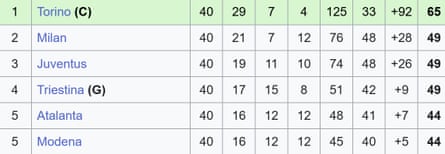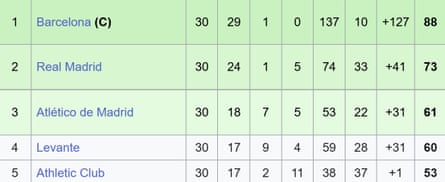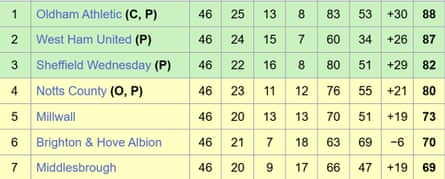“During the Liechtenstein v Scotland game there was a reference to Billy Gilmour scoring more goals for Scotland (2) than his various clubs (0). But has a recognised striker ever finished their career with more goals for their country than their clubs?” asks Stuart McLagan.
The structure of women’s football in North America, particularly before the NWSL was founded in 2012, makes it the likeliest source of an answer to this question. There was no league at all in the US between 2003 and 2009, and to this day players sometimes appear more for their country than their club in a calendar year.
“Look no further than Canadian legend Christine Sinclair,” writes Redmond Grimes. “She scored 190 goals for country and 127 for various clubs.” Sinclair also scored more than 110 goals in college football for Portland but they are not included in a domestic career tally.

Sinclair’s 190 goals for Canada are a record for any country, and Tom Wendt points out that Nos 2 and 3 on the list were also more prolific for country than club. A lot more prolific. Abby Wambach hit 184 and 75 respectively, Mia Hamm 158 and 28.

“Many of the United States’ top strikers from that era had surprisingly low club goal counts,” adds Ben Cordes. “Even if you add Abby Wambach’s 96 goals for her college team, it doesn’t match her international record.” Ben sent a list of some other USWNT strikers who did their best work at international level.
-
Kristine Lilly 130/30
-
Michelle Akers 107/19
-
Tiffeny Milbrett 100/71
-
Cindy Parlow Cone 75/15
We couldn’t find any examples from men’s football, though Russell Connor came close with the story of Qatar’s all-time leading scorer, Almoez Ali. He has scored 60 times for his country and about 84 times for his various clubs. Close, but no Knowledge™-branded cigar.
GD chasms between league-table neighbours
“Spurs ended up 17th with a goal difference of -1, Leicester were one place lower with a GD of -47. Has there ever been a larger GD disparity between two teams next to each in the final standings?” asks Dean.
Has there? Has there ever! Such disparities are increasingly common, with mini-leagues often forming at the top and bottom of tables. What makes the Spurs/Leicester example stand out is that Leicester didn’t finish bottom. These cases usually involve either runaway leaders – or two runaways leaders in the case of certain duopolies – or teams who are marooned with a goal difference of -400.
Let’s start in Serie A, where Il Grande Torino won four titles in a row before the Tragedy of Superga in 1949. The third of those, in 1947-48, was won by the astonishing margin of 16 points (two for a win in those days, remember). Torino scored 125 goals in their 40 games – 91 of them at home – and finished with a goal difference of +92. That was 64 ahead of the next best: the runners-up Milan, whose +28 figure looked pitiful in comparison.

A disparity of 64 goals is astonishing for the middle of the 20th century, when league tables were generally a lot denser. Inevitably, it has been beaten more recently – including once apiece by both Barcelona teams.
In 2011-12, Barcelona were runners-up to José Mourinho’s relentless Real Madrid. Barça’s goal difference was +85, a whopping 70 goals ahead of third-place Valencia.
Twelve years later, in Liga F, Barça romped to the title with a goal difference of +127. They scored at least five times in half of their 30 league games, and their goal difference was 86 ahead of the runners-up Real Madrid (+41).

Here’s a list of some of the greatest top-flight disparities we could find.
86 – Liga F, 2023-24
1. Barcelona + 127; 2. Real Madrid +41
70 – La Liga, 2011-12
2. Barcelona +85; 3. Valencia +15
64 – Serie A 1947-48
1. Torino +92; 2. AC Milan +28
59 – Ligue 1 2015-16
1. PSG +83; 2. Lyon +24
53 – Liga F 2024-25
1. Barcelona +112; Real Madrid +59
53 – Premier League 2007-08
19. Birmingham -16; Derby -69
The Mensa contenders among you will have noticed these all involve at least one team in the top or bottom two. In some ways the more interesting examples are elsewhere, when the goal-difference disparity exists despite teams having roughly the same number of points.
An intrepid Norwich side finished third in the inaugural Premier League season of 1992-93, one point and one place ahead of Blackburn Rovers. But Norwich’s goal difference of -4 was 26 worse than Blackburn. Twelve of those 12 goals came in one hit when Blackburn beat Norwich 7-1 at Ewood Park in October 1992.

Sixth-placed Chelsea were 37 goals better off than seventh-placed West Ham in 2001-02, although there were 11 points between the teams on that occasion. A similar thing happened three seasons earlier, when an exciting but hammerable West Ham side finished fifth in the Premier League with a goal difference of -7. Leeds, 10 points better on in fourth place, were +28.
Last and arguably least, an odd little table from the second tier in 1990-91, when Brighton were sandwiched between goal-difference superiors in Millwall and Middlesbrough. They thrashed Millwall in the playoff semi-final, only to lose to Notts County at Wembley.

A rare feat in heroic Welsh defeat
“My team, Wales, went down to a heroic 4-3 defeat by Belgium last week,” writes David Thomas. “Wales rarely score three goals, and when they do it’s usually against minnows. Have they ever scored three in a defeat before?”
Alas they have, David, though you have to go back to a madcap 6-4 defeat in Turkey during qualification for France 98'. Before that there were at least four relevant losses in the British Home Championship. Three of those were before the war, though. So unless we’ve missed a game, the Belgium game was only the third time in the last century that Wales had scored at least three goals and been beaten.
-
1891 Wales 3-4 Scotland
-
1893 Ireland 4-3 Wales
-
1913 England 4-3 Wales
-
1969 Wales 3-5 Scotland
Knowledge archive
“Everyone seems to be obsessed with record crowds nowadays,” sighed Andy McKenzie back in 2008. “But the other day as I was talking to a friend about Scottish lower division football, we wondered what it would be like to watch Queen’s Park at Hampden. This season they have had crowds of fewer than 500 in a 52,000 capacity stadium, meaning over 51,500 empty seats. What is the record number of empty seats there have been at a major league or cup match?”
[2025 note: there were a reported 48,863 empty seats at Chelsea’s Club World Cup game against LAFC on Monday.]

The Knowledge inbox has been bulging (if an inbox can bulge) with bids for this particular crown. Here’s our top 10:
10. Yokohama Marinos – 51,207
“The capacity of the Nissan Stadium (AKA Yokohama International Stadium) is 72,372,” writes Richard Finch, “and has been used by Yokohama Marinos since 1998 when the average attendance was 19,165. A quick subtraction results in an average of 51,207 unused seats.” Not a bad effort, but we can do better than that …
9. FC Amsterdam – 64,500
Over to Nick den Uijl. “In the 70s, FC Amsterdam played in the Eredivisie. Their home stadium was the Olympic Stadium in Amsterdam. They would play in front of only a handful of people. In September 1977, for instance, they lost 1-3 to FC Twente in front of 1,500 spectators. Earlier that year the Cup Winners’ Cup final was played between Hamburg and Anderlecht in the same stadium in front of 66,000 people.”
8. Juventus – 68,763
“Assuming we are discounting several games played behind closed doors,” says Simon Halstead (and yes, we are), “I would have to say Juventus’ Coppa Italia home match against Sampdoria in the 2001-02 season. Only 237 spectators showed up. With the Stadio Delle Alpi’s capacity of 69,000 this leaves 68,763 empty seats.” Thanks also to David Pasley, who suggested this fixture.
Can you help?
“Fabián Cancelarich, Argentina’s reserve keeper at Italia 90, never played for his country but was apparently included in around 30 squads. I wondered if that was a record. Couldn’t be bothered to work it out as I’m on holiday. Can you?” asks Craig Wilkinson.
“Last week Senegal became the first African team to beat England,” notes Pablo Miguez. “This made me wonder: which country has the longest unbeaten streak against African teams? What about against Asian/European teams?”

“Newcastle’s third kit features a different club badge from the home and away kits, which means when they wear it the goalkeeper has a different badge on his shirt. Are there any other instances of this?” asks Andy Foreman-Lonn.
“It’s exceedingly rare for European clubs to play competitive football in mid-June, as they are now at the Club World Cup. I would imagine up until the Covid-affected 2019-20 season (which went into July), there were dates on the calendar on which European club football had never been played. Can anyone come up with one?” asks George Jones. “If a match has been played on that date in any year it doesn’t count.”

 3 months ago
81
3 months ago
81

















































